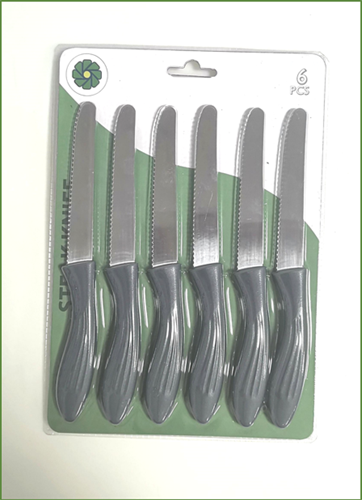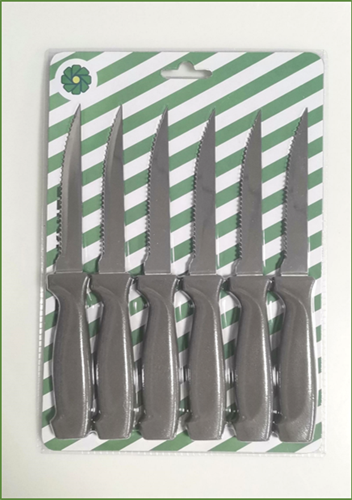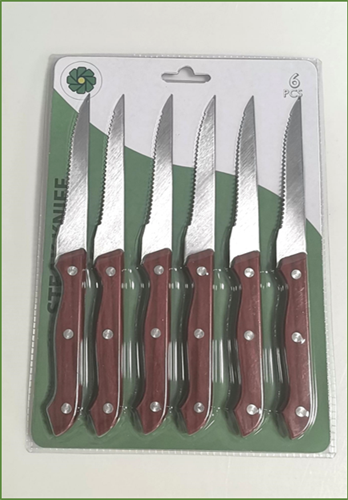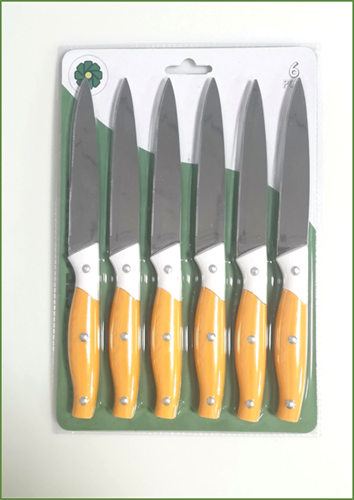

Views: 900 Author: sales@insightknife.com.cn Publish Time: 2025-01-06 Origin: Site








Content Menu
>>> Advantages of Serrated Knives
>>> Disadvantages of Serrated Knives
>> Straight-Edged Steak Knives
>>> Advantages of Straight-Edged Knives
>>> Disadvantages of Straight-Edged Knives
● Choosing the Right Steak Knife
>> Blade Shape
● Maintenance and Care for Steak Knives
>> Cleaning
>> Sharpening
>> Storage
● Frequently Asked Questions regarding Steak Knives
>> 1. What is the difference between serrated and straight-edged steak knives?
>> 2. How should I clean my steak knives?
>> 3. How often should I sharpen my steak knives?
>> 4. What materials are best for steak knife handles?
>> 5. Can I use my steak knives for other types of food?
When it comes to enjoying a perfectly cooked steak, the right knife can make all the difference. Steak knives are specifically designed to enhance the dining experience by providing the necessary precision and ease of cutting. The right knife not only improves the ease of slicing through meat but also contributes to the overall enjoyment of the meal. In this article, we will explore the various shapes and styles of steak knives, their features, and how to choose the best one for your needs.
Steak knives are essential tools in any steak lover's kitchen. They are designed to cut through meat with minimal effort, ensuring that the steak retains its juices and flavor. The two primary types of steak knives are serrated and straight-edged, each offering unique advantages. Understanding these types can help you appreciate the craftsmanship behind each knife and how it can enhance your dining experience.
Serrated steak knives feature a blade with a series of small, jagged edges. This design allows the knife to grip the meat as it cuts, making it easier to slice through tougher cuts without tearing the fibers. The serrated edge is particularly effective for cutting through the crust of a well-cooked steak while preserving the tender interior. Serrated knives are often preferred for their ability to stay sharp longer, as the serrations help maintain the cutting edge. This longevity makes them a practical choice for both casual diners and serious steak enthusiasts.
Ease of Use: The serrated edge grips the meat, allowing for a smoother cutting motion. This feature is especially beneficial when dealing with thicker cuts of meat, where a clean slice is essential to avoid tearing.
Durability: These knives tend to require less frequent sharpening compared to straight-edged knives. The design of the serrated edge means that even as it dulls, it still retains some cutting ability, making it a reliable choice for everyday use.
Versatility: Serrated knives can be used for various foods, including bread and fruits, making them a versatile addition to your kitchen. This multi-functionality means that a good serrated knife can serve multiple purposes, reducing the need for a large collection of specialized knives.


Less Precision: The jagged edge can sometimes lead to uneven cuts, especially with delicate meats. This can be a drawback for those who appreciate the aesthetics of a perfectly sliced steak.
Difficult to Sharpen: Sharpening serrated knives can be challenging, requiring specialized tools or professional sharpening services. This can be a disadvantage for those who prefer to maintain their knives at home.
Straight-edged steak knives have a smooth, sharp blade that allows for clean, precise cuts. These knives are favored by many chefs and steak enthusiasts for their ability to slice through meat without tearing. The straight edge provides a level of control that is often preferred when serving high-quality cuts of meat, where presentation is key.
Precision Cutting: The smooth edge allows for clean cuts, preserving the meat's texture and juices. This precision is particularly important for gourmet dining experiences, where the visual appeal of the dish is as important as the taste.
Easier to Sharpen: Straight-edged knives can be sharpened easily with a whetstone or honing rod. This ease of maintenance means that you can keep your knives in top condition without needing to seek professional help.
Aesthetic Appeal: Many straight-edged knives feature elegant designs, making them visually appealing for table settings. A well-crafted knife can enhance the overall dining experience, adding a touch of sophistication to your meal.
Less Effective on Tough Cuts: Straight-edged knives may struggle with tougher cuts of meat, requiring more effort to slice through. This can be a consideration when choosing a knife for a variety of meats, especially if you often serve less tender cuts.
Frequent Sharpening: These knives may need to be sharpened more often to maintain their cutting performance. Regular maintenance is essential to ensure that the knife performs well over time.


When selecting a steak knife, several factors should be considered to ensure you choose the best option for your needs. The right knife can enhance your dining experience, making each meal more enjoyable.
The material of the blade plays a crucial role in the knife's performance and durability. Common materials include stainless steel and carbon steel. Each material has its own set of characteristics that can influence your choice.
Stainless Steel: Known for its resistance to rust and corrosion, stainless steel is a popular choice for steak knives. It offers a good balance of sharpness and durability, making it suitable for everyday use. Additionally, stainless steel knives are often easier to care for, as they do not require as much maintenance as other materials.
Carbon Steel: While carbon steel knives can achieve a sharper edge, they require more maintenance to prevent rusting. They are often favored by professional chefs for their superior cutting performance. The ability to achieve a razor-sharp edge makes carbon steel knives a favorite among those who prioritize performance over convenience.
The handle of a steak knife should provide a comfortable grip and allow for precise control while cutting. Common handle materials include wood, plastic, and metal. The choice of handle can significantly affect the overall feel and usability of the knife.
Wood: Wooden handles offer a classic look and a comfortable grip. However, they may require more care to maintain their appearance. Wood can absorb moisture and odors, so it is essential to clean and dry wooden handles properly after use.
Plastic: Plastic handles are lightweight and easy to clean, making them a practical choice for everyday use. They are often available in a variety of colors and designs, allowing for personalization in your kitchen.
Metal: Metal handles provide a modern aesthetic and are often more durable, but they can be slippery when wet. Some metal handles feature textured grips to enhance control, making them a viable option for those who prefer a contemporary look.
The shape of the blade can also influence the knife's performance. Common blade shapes include curved, straight, and pointed. Each shape has its own advantages and is suited for different cutting tasks.
Curved Blades: Curved blades are designed to follow the natural contours of the meat, making them ideal for slicing through larger cuts. The curve allows for a rocking motion that can make cutting easier and more efficient.
Straight Blades: Straight blades offer precision and control, making them suitable for delicate cuts. This shape is often preferred for fine dining, where presentation and accuracy are paramount.
Pointed Blades: Pointed blades are excellent for piercing through tough surfaces, allowing for easier access to the meat. This feature can be particularly useful when dealing with thicker cuts or when preparing meat for cooking.
To ensure the longevity and performance of your steak knives, proper maintenance and care are essential. Taking the time to care for your knives can significantly extend their lifespan and maintain their cutting performance.
After each use, it is important to clean your steak knives thoroughly. Hand washing is recommended to prevent damage to the blade and handle. Avoid using abrasive sponges or harsh detergents, as these can scratch the surface. Instead, use a soft cloth or sponge with mild soap and warm water. Dry the knives immediately to prevent water spots and rust.
Regular sharpening is crucial for maintaining the cutting performance of your steak knives. For straight-edged knives, use a whetstone or honing rod to keep the edge sharp. It is advisable to sharpen your knives regularly, especially if you use them frequently. Serrated knives may require professional sharpening or specialized tools, as maintaining the serrated edge can be more complex.
Proper storage is vital to prevent damage to the blades. Consider using a knife block, magnetic strip, or protective sheaths to keep your knives safe and organized. Storing knives properly not only protects the blades but also ensures that they are easily accessible when needed. Avoid tossing knives into a drawer, as this can lead to dulling and damage.
Choosing the best knife shape for steak ultimately depends on personal preference and the types of meat you typically enjoy. Whether you opt for a serrated or straight-edged knife, understanding the features and benefits of each will help you make an informed decision. With the right steak knife in hand, you can enhance your dining experience and enjoy every bite of your perfectly cooked steak. Investing in quality steak knives is not just about functionality; it is about elevating your culinary experience and making every meal a special occasion.
Serrated steak knives have a jagged edge that grips the meat, making them easier to use on tougher cuts. They tend to stay sharp longer but can be harder to sharpen. Straight-edged steak knives have a smooth blade that allows for precise cuts, making them ideal for tender meats, but they may require more frequent sharpening.
It is best to hand wash steak knives with warm, soapy water and a soft sponge. Avoid using abrasive materials that can scratch the blade. After washing, dry them immediately to prevent rust and water spots.
The frequency of sharpening depends on usage. For straight-edged knives, sharpening every few months is recommended, while serrated knives may need professional sharpening or specialized tools less frequently, as they tend to retain their edge longer.
Common materials for steak knife handles include wood, plastic, and metal. Wooden handles offer a classic look and comfort, plastic handles are lightweight and easy to clean, and metal handles provide durability and a modern aesthetic. The choice depends on personal preference and intended use.
Yes, while steak knives are designed for cutting meat, they can also be used for other foods like bread, fruits, and vegetables. However, for optimal performance and to maintain their sharpness, it is best to use them primarily for their intended purpose.